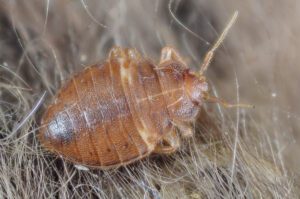Bedbugs have infested Paris and other big cities, too. Learn how to recognize infestations when traveling and avoid them.

Bedbugs invade Paris is a headline you will see when you read about visiting Paris today. News reports state that buses, the Metro, theaters, and the Paris Charles de Gaulle Airport are infested. Homes, movie theaters, trains, hospitals, hotels, and vacation rentals have bedbug infestations. The French national and Paris city governments are markedly concerned with the Paris Olympics upcoming in less than a year.
Bedbug infestations aren’t just in Paris. They’re all over the world.
While infestations are widely reported in Paris, bedbug infestations can occur whenever and wherever you travel.
Bedbugs are small, flat, reddish-brown, wingless, parasitic insects. They’re about half the size of a US Lincoln penny. They feed on the blood of sleeping people and animals.
When bedbugs invade Paris — or anywhere — even clean, five-star locations can be infested.

When you hear bedbugs invade Paris, know that they are not dangerous, but nasty.
The CDC (Centers for Disease Control and Prevention) states that bedbugs aren’t considered dangerous or spread disease. Still, some people have allergic reactions to their bites that require medical attention. For most people, bedbug bites are beyond annoying. The bites cause itching and sleep loss. For many, the itching, according to the CDC, “can lead to excessive scratching that can sometimes increase the chance of a secondary skin infection.” I know too many people whose vacations were ruined by those bites and subsequent infections.
Just as bad is when travelers bring home bedbugs in their luggage or clothing and must spend time and money eradicating them at home. Bedbug infestations are particularly challenging to remove. Sometimes, you can be lucky and eliminate them before they infest your home. If they become an infestation, you’ll have to call in professional bedbug cleaning services that may have to fumigate. According to professionals in my home region, bedbug extermination can cost between $500 and $5,000, according to the infestation.
Be alert and take precautions to prevent belongings from being infested.
Your best bet is to be as careful as possible by taking reasonable precautions to avoid contact with bedbugs while traveling and not let them hitch a ride home.
Before you travel:
Choose the right luggage. Bedbugs can climb onto any surface. They like to hide in cracks and crevices — the deeper, the better, because light can’t shine into deep ones. Therefore, using hard-sided rather than fabric-sided luggage will tend not to allow bedbugs to attach themselves to the luggage.
Bedbugs can be lurking at the airport and on aircraft.
At the airport:
It’s less likely that bedbugs will be hanging around in brightly lighted areas at airports. Choose seating that isn’t upholstered, if possible. Upholstered furniture is more likely to hide bedbugs in its crevices.
On your flights:
The likely spots for bedbugs on your plane flight are in the seats and the overhead bins. If you’re concerned, you can look in your seat crevices with a flashlight. In the overhead bin, look for staining or little reddish-brown dots, especially in the corners of the overhead bin.
Know signs that point to bedbug presence in hotels and vacation rental properties.
Learn to recognize bedbug presence. Clues for travelers indicating a bedbug infestation in their room include:
- Discarded bedbugs’ exoskeletons after molting,
- Rusty–colored blood spots from bedbugs’ blood-filled fecal material excreted on the mattress, mattress pad, sheets, or nearby furniture,
- Bedbugs are seen in the folds of mattresses and sheets during an inspection after entering your room,
- A sweet, musty odor in your hotel room.
At your hotel room or vacation rental property, inspect your room/property upon arrival:
- Immediately after you arrive, place your belongings in a safe place. For me, that’s the bathroom where bedbugs can’t hide. My bags go directly into the bathtub or, if none, the shower.
Tip: Bring a small, bright LED flashlight to help you inspect your room.
- Inspect the beds and bed linen in your room carefully. Strip the bed of all linen and the mattress pad. Scrutinize the mattress and the box spring, if any. Use a flashlight to examine the bed frame as well as possible. Carefully check all bed linens and pads for tell-tale signs of bedbug presence. Then, check all the upholstered furniture in your room. Check the closets, too.
- If you find bedbugs, move to another room at least two floors away, if not another hotel. If at a vacation property, call the correct number to report property problems and try to move to another property. At a vacation property, start a paper trail, too. Send an email or at least a text message.
Even if your room or property looks good, take precautions because bedbugs are skillful at hiding.
If your room or property looks good, take precautions anyway. Bedbugs are adept at hiding and, in hotels, can be carried from an infested room to one that is initially not infested:
- Keep your luggage off the floor. Use a luggage rack (after you inspect it), a desktop, the top of a chest or dresser, or an unupholstered chair or bench.
- Keep your belongings in your luggage. Don’t use the dresser or other drawers in your room.
- If you are traveling with young children, ensure that stuffed animals stay off the floor and are stowed in plastic bags with your luggage when you’re out of the room.
Soiled laundry attracts bedbugs. Keep it off the floor and in sealed plastic bags.
- Keep your soiled laundry off the floor, even in a laundry bag. Don’t use cloth laundry bags. According to a study by William T. Hentley, Ben Webster, Sophie E.F. Evison, and Michael T. Siva-Jothy published in Springer Nature, bedbugs are twice as likely to aggregate on bags containing soiled clothes than clean ones. Stow your soiled laundry in a sealed plastic bag.
When you arrive home, unpack directly into your dryer.
If you suspect you’ve brought home bedbugs from your journey, immediately unpack your clothes directly into your dryer, not the washer. Put the clothes you wore home in the dryer, too. You can wash them after running them through a dryer cycle. Because the hot water at home is insufficient to kill bedbugs, you must put them in the dryer on high for 30 minutes. For clothes that need dry cleaning, put them in a sealed plastic bag and get them cleaned as quickly as possible.
You can encounter bedbugs on any journey. Be aware of the possibility and take the above-listed actions to minimize your potential contact with them.
READ ALSO:
Look out! Airlines are setting a carry-on luggage trap
5 airport security mistakes that could delay you, make you miss your flight, or worse
After many years working in corporate America as a chemical engineer, executive and eventually CFO of a multinational manufacturer, Ned founded a tech consulting company and later restarted NSL Photography, his photography business. Before entering the corporate world, Ned worked as a Public Health Engineer for the Philadelphia Department of Public Health. As a well known corporate, travel and wildlife photographer, Ned travels the world writing about travel and photography, as well as running photography workshops, seminars and photowalks. Visit Ned’s Photography Blog and Galleries.



